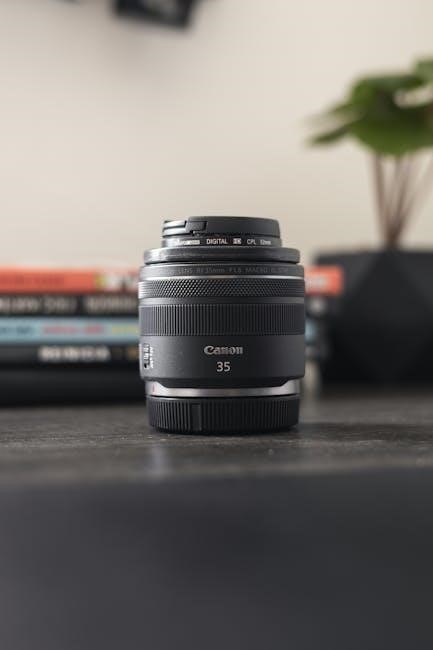The Canon PowerShot SX60 HS is a high-performance bridge camera with a 65x zoom lens, CMOS sensor, and advanced features for versatile photography and video recording․
1․1 Overview of the Camera
The Canon PowerShot SX60 HS is a versatile bridge camera designed for both enthusiasts and professionals․ It features a 16․1MP CMOS sensor, a 65x optical zoom lens (21-1365mm equivalent), and a 3-inch vari-angle LCD screen․ The camera supports 1080p HD video recording at 60fps and offers built-in Wi-Fi and NFC for seamless connectivity․ With its ergonomic design and advanced autofocus system, it excels in capturing distant subjects and dynamic scenes․ The SX60 HS also includes manual controls, ensuring creative flexibility․ Its robust feature set makes it ideal for wildlife, sports, and travel photography, providing high-quality images and videos in various lighting conditions․
1․2 Importance of the User Manual
The Canon PowerShot SX60 HS user manual is an essential resource for mastering the camera’s features and functions․ It provides detailed guidance on initial setup, menu navigation, and advanced settings, ensuring users can fully utilize the camera’s capabilities․ The manual also includes troubleshooting tips and explanations of error messages, helping to resolve common issues quickly․ By understanding the camera’s operation through the manual, users can enhance their photography skills, optimize settings for various scenarios, and maintain the device properly․ It serves as a comprehensive guide to unlocking the camera’s full potential and achieving the best results in different shooting conditions․

Key Features and Specifications
The Canon PowerShot SX60 HS features a 16․1MP CMOS sensor, 65x optical zoom, 21-1365mm lens, Wi-Fi, NFC, and 1080p video recording capabilities, delivering high-quality images and versatility․
2․1 Image Sensor and Resolution
The Canon PowerShot SX60 HS is equipped with a 1/2․3-inch CMOS image sensor, offering a maximum resolution of 4608 x 3456 pixels․ This sensor ensures high-quality images with vibrant colors and sharp details․ It supports multiple still image resolutions, including 4608 x 3456, 3264 x 2448, and 2272 x 1704 pixels, providing flexibility for various shooting needs․ The CMOS technology enhances light sensitivity, reducing noise and enabling better low-light performance․ Additionally, the sensor supports advanced autofocus and features like face detection, ensuring precise and quick focusing․ These features make it suitable for capturing a wide range of scenes, from portraits to landscapes․
2․2 Zoom Capabilities
The Canon PowerShot SX60 HS boasts an impressive 65x optical zoom lens, covering a focal length range of 21-1365mm (35mm equivalent)․ This extensive zoom range allows photographers to capture distant subjects, such as wildlife or distant landscapes, with remarkable clarity․ The lens also features a 130x digital zoom for extreme close-ups when needed․ Optical Image Stabilizer technology minimizes camera shake, ensuring sharp images even at maximum zoom․ The zoom control is smooth and precise, enabling easy framing and composition․ This feature makes the SX60 HS ideal for versatile shooting scenarios, from wide-angle shots to super-telephoto captures, catering to both casual and advanced photographers․
2․3 Display and Viewfinder
The Canon PowerShot SX60 HS features a 3․0-inch LCD screen with a resolution of 922,000 dots, providing clear and vibrant image preview and playback․ The Vari-Angle display allows for flexible shooting from various angles, making it ideal for both high and low-angle compositions․ Additionally, the camera is equipped with an electronic viewfinder (EVF) with 100% coverage, offering a more traditional shooting experience․ The EVF features a 0․5-inch LCD with 1․15 million dots and a 22mm eye-point, ensuring comfortable and precise framing․ Both the LCD and EVF include anti-glare coatings to enhance visibility in bright lighting conditions, making the SX60 HS versatile for use in diverse environments․
2․4 Video Recording Features
The Canon PowerShot SX60 HS supports high-quality video recording with Full HD 1080p resolution at 60 frames per second, ensuring smooth and detailed footage․ It also offers 1080p at 30 fps and lower resolutions for versatility․ The camera features a dedicated movie button for quick recording and supports manual controls during video capture, allowing users to adjust settings like aperture and shutter speed․ Additionally, the SX60 HS includes built-in stereo microphones for clear audio and enhanced Dynamic Image Stabilization to reduce camera shake, particularly useful for handheld shooting; Users can also capture still images while recording video, making it a versatile option for hybrid shooters․

Getting Started with the Canon PowerShot SX60 HS
Getting started with the Canon PowerShot SX60 HS involves unboxing, charging, and basic setup․ It features a 65x zoom lens, image stabilization, and Wi-Fi connectivity for enhanced usability․ The user manual and software downloads provide comprehensive guidance for initial configuration and operation․
3․1 Unboxing and Initial Setup
Unboxing the Canon PowerShot SX60 HS reveals the camera, lens cap, neck strap, battery, charger, and user manual․ Initial setup involves charging the battery, attaching the strap, and powering on the camera․ Familiarize yourself with the mode dial, zoom lever, and other controls․ Set the date, time, and language preferences via the menu․ Refer to the user manual for detailed instructions on first-time configuration, ensuring optimal performance and personalized settings for your photography needs․ Proper setup ensures a smooth start to capturing high-quality images with this versatile camera․
3․2 Charging the Battery
Charging the Canon PowerShot SX60 HS battery is essential before first use․ Insert the supplied NB-10L battery into the charger, ensuring proper alignment of the terminals․ Plug the charger into a power outlet and wait for the charging indicator to turn red․ Charging typically takes 1-2 hours, depending on the battery’s depletion level․ Once fully charged, the indicator will turn green․ Avoid overcharging, as it may reduce battery longevity․ Always use the Canon-approved charger to ensure safety and compatibility․ Refer to the user manual for detailed charging guidelines and troubleshooting tips to maintain optimal battery performance and camera functionality․
3․3 Basic Camera Controls
The Canon PowerShot SX60 HS features an intuitive control layout designed for easy operation․ The Mode Dial on top allows quick switching between shooting modes, such as Auto, P, Tv, Av, M, and Movie Mode․ The Zoom Lever enables smooth zooming in and out, while the Shutter Button captures images or starts video recording․ The Power Button is conveniently located on the top right for turning the camera on/off․ The Multi-Selector (D-pad) on the rear helps navigate menus and adjust settings․ The FUNC․ button provides quick access to frequently used settings, and the Flash button activates the built-in flash for low-light conditions․ These controls ensure efficient and user-friendly camera operation․

Operating Modes
The Canon PowerShot SX60 HS offers various operating modes, including Automatic and Manual, each designed for different shooting scenarios to help users achieve desired results․
4․1 Automatic Mode
The Canon PowerShot SX60 HS features an Automatic Mode that simplifies photography for beginners and casual shooters․ This mode automatically adjusts settings like aperture, shutter speed, and ISO to ensure optimal results in various lighting conditions․ It also selects the most suitable scene type, such as Portrait, Landscape, or Low Light, to enhance image quality․ Automatic Mode is ideal for users who prefer point-and-shoot convenience without manually adjusting settings․ The camera’s advanced algorithms work to deliver sharp, well-exposed photos and videos effortlessly, making it perfect for everyday use and capturing spontaneous moments․ This mode is a great starting point for those new to photography or seeking hassle-free shooting experiences․
4․2 Manual Mode
Manual Mode on the Canon PowerShot SX60 HS offers advanced control over camera settings, allowing users to fine-tune their photography․ This mode enables manual adjustment of aperture, shutter speed, ISO, and focus, providing creative freedom for precise results․ Users can experiment with depth of field, motion effects, and low-light performance by customizing these settings․ The camera’s manual controls are intuitive, with a control dial and accessible menu options․ This mode is ideal for intermediate to advanced photographers seeking to express their artistic vision․ By mastering Manual Mode, users can unlock the full potential of the SX60 HS, capturing images that reflect their unique style and expertise․

Menu Functions
The Canon PowerShot SX60 HS menu functions provide easy access to shooting, playback, and setup options, allowing users to customize features and optimize their photography experience effectively․
5․1 Shooting Menu
The Shooting Menu on the Canon PowerShot SX60 HS offers extensive customization options for capturing images․ Users can adjust settings like ISO sensitivity, white balance, and autofocus modes to suit various shooting conditions․ Additionally, the menu provides options for enabling RAW image capture, which preserves more data for post-processing․ Features like Dynamic Range Correction and Shadow Correction can also be accessed here to enhance image quality․ Customizing the Shooting Menu allows photographers to tailor the camera’s settings to their personal preferences, ensuring optimal results in different lighting scenarios and subject compositions․
5․2 Playback Menu
The Playback Menu on the Canon PowerShot SX60 HS enables users to review and manage their captured images․ Key features include the ability to play slideshows, protect images from deletion, and rotate photos․ Users can also apply in-camera editing options, such as resizing images or cropping to focus on specific details․ Additionally, the menu allows for filtering images by date or category, making it easier to organize and locate specific photos․ The Playback Menu is essential for efficiently reviewing and managing your photo library directly on the camera, ensuring your memories are preserved and easily accessible for sharing or further editing․
5․3 Setup Menu
The Setup Menu on the Canon PowerShot SX60 HS allows users to configure various camera settings for personalized use․ It includes options like setting the date and time, selecting the camera’s language, and formatting memory cards․ Users can customize the LCD screen brightness and adjust volume settings for playback․ Additional features enable the customization of camera behavior, such as auto-rotating images or setting the time zone․ This menu is essential for tailoring the camera to individual preferences, ensuring a seamless and efficient shooting experience․ By adjusting these settings, users can optimize their workflow and enhance their overall photography sessions with the SX60 HS․
5․4 Customizing My Menu
Customizing My Menu on the Canon PowerShot SX60 HS enables users to streamline their workflow by saving frequently used settings for quick access․ This feature allows you to create a personalized menu with up to six of your most-used options, such as image quality, ISO settings, or autofocus modes․ To customize My Menu, navigate to the main menu, select “My Menu,” and choose “Add Items․” Use the directional buttons to select desired settings and confirm․ You can also rearrange items for easier access․ This feature enhances efficiency, ensuring that your go-to settings are always just a few clicks away, making your shooting experience faster and more intuitive․

Downloading and Installing Software
Visit the Canon website to download essential software like ImageBrowser EX and Camera Connect App, ensuring compatibility and optimal performance for your PowerShot SX60 HS;
6․1 Canon ImageBrowser EX
Canon ImageBrowser EX is a dedicated software for managing and enhancing images captured with the PowerShot SX60 HS․ It allows users to import, organize, and edit photos efficiently․ The software supports various image editing tools and provides options for sharing and printing․ ImageBrowser EX is compatible with the SX60 HS and can be downloaded from the Canon website․ It offers features like image tagging, filtering, and basic adjustments to enhance your photography experience․ This program is essential for users looking to streamline their post-capture workflow and make the most of their camera’s capabilities․ Ensure to download the latest version for optimal performance with your PowerShot SX60 HS․
6․2 Camera Connect App
The Camera Connect App is a versatile smartphone application designed to enhance the functionality of the Canon PowerShot SX60 HS․ It enables seamless wireless connectivity, allowing users to transfer images directly to their mobile devices for easy sharing․ The app also supports remote shooting, providing a live preview of the camera’s viewfinder on the smartphone screen․ Users can adjust settings like zoom, focus, and shutter release remotely, making it ideal for capturing images from unique angles․ Compatible with both iOS and Android, the Camera Connect App simplifies photo management and sharing, offering a convenient way to enhance your photography experience with the SX60 HS․
6․3 Other Compatible Software
In addition to Canon ImageBrowser EX and the Camera Connect App, the PowerShot SX60 HS supports other software for enhanced functionality․ Adobe Lightroom and Photoshop are popular choices for advanced image editing and management․ Canon’s Digital Photo Professional is another option for processing RAW files, offering precise control over image parameters․ Third-party apps like Google Photos and Flickr can also be used for storing and sharing images․ These tools complement the camera’s capabilities, providing users with a comprehensive ecosystem for managing and enhancing their photos․ They can be downloaded from Canon’s official website or through trusted software platforms, ensuring compatibility and optimal performance with the SX60 HS․

Using the 65x Zoom Lens
The Canon PowerShot SX60 HS features a 65x zoom lens, covering 21-1365mm, with excellent optical performance and image stabilization, ideal for capturing distant subjects with clarity․
7․1 Tips for Effective Zooming
For optimal results with the 65x zoom lens, use a tripod to minimize handheld shake․ Enable Optical Image Stabilizer to reduce blur․ Shoot in RAW for better details․ Use the zoom lock to prevent lens creep during transport․ Focus on stationary subjects for sharp images․ Avoid extreme zoom in low light to prevent noise․ Use the zoom ring smoothly for video recording․ Experiment with framing to make the most of the lens’s range․ Regularly clean the lens for clear images․ These practices enhance your photography experience with the PowerShot SX60 HS․

Wi-Fi and NFC Connectivity
The Canon PowerShot SX60 HS features built-in Wi-Fi and NFC, enabling easy image transfer to smartphones and remote shooting via the Camera Connect app for enhanced connectivity․
8․1 Setting Up Wi-Fi
To set up Wi-Fi on the Canon PowerShot SX60 HS, go to the camera’s menu and select the Wi-Fi option․ Choose the desired network from the list and enter the password if required․ For a quicker connection, use the NFC feature by tapping your NFC-enabled device to the camera․ Once connected, you can transfer images to your smartphone or tablet using the Camera Connect app․ This setup allows for seamless sharing of photos and remote camera control․ Ensure both devices are connected to the same network for a stable connection․ This feature enhances the camera’s functionality, making it easier to share your creations instantly․
8․2 Transferring Images
Transferring images from the Canon PowerShot SX60 HS to your device is straightforward․ Once Wi-Fi is set up, select the images you wish to transfer using the camera’s menu․ Choose the “Transfer” option and specify the destination device․ Using the Camera Connect app, images can be sent directly to your smartphone or tablet․ You can transfer individual photos or multiple files at once․ Ensure both devices are connected to the same network for a smooth transfer․ This feature allows for easy sharing and backup of your photos without the need for cables․ The app also enables remote shooting, enhancing your photography experience with convenience and flexibility․

Custom Settings and Control Customization
Customize your camera settings to match your photography style․ Assign functions to buttons, tailor menu options, and create a personalized interface for an enhanced shooting experience․
9․1 Customizing Controls
The Canon PowerShot SX60 HS allows users to customize camera controls to suit their preferences․ Assign frequently used functions to buttons like the Shortcut Button for quick access․ Customize the camera’s controls by assigning functions such as ISO, white balance, or focus modes to specific buttons․ Additionally, users can create a personalized interface by customizing the menu options, ensuring that frequently used settings are easily accessible․ This feature enhances shooting efficiency and allows for a more tailored photography experience․ By personalizing the controls, users can streamline their workflow and focus more on capturing the perfect shot․

Troubleshooting Common Issues
Resolve issues like camera not turning on, blurry images, or memory card errors by checking battery life, memory card compatibility, and settings․ Resetting the camera or consulting the manual often helps address common problems effectively․
10․1 Common Problems and Solutions
Common issues with the Canon PowerShot SX60 HS include the camera not turning on, blurry images, or memory card errors․ For the camera not turning on, ensure the battery is fully charged and properly inserted․ Blurry images may result from incorrect autofocus settings or camera shake; try using a tripod or enabling image stabilization․ Memory card errors can often be resolved by formatting the card in the camera or using a card reader․ Wi-Fi connectivity issues can be fixed by resetting the camera’s network settings․ If problems persist, resetting the camera to factory settings or consulting the user manual may provide solutions․
The Canon PowerShot SX60 HS is a versatile and powerful bridge camera designed for both beginners and advanced photographers․ With its 65x zoom lens, Wi-Fi connectivity, and robust feature set, it offers exceptional flexibility for capturing high-quality images and videos․ The user manual provides comprehensive guidance to unlock its full potential, ensuring users can navigate its advanced settings and troubleshooting common issues․ By following the manual and exploring its capabilities, photographers can achieve professional-grade results․ For further support, Canon’s official website offers additional resources, including software downloads and customer support․ Mastering the SX60 HS empowers users to take their photography to new heights, making it an excellent choice for creative enthusiasts and professionals alike․


























































































